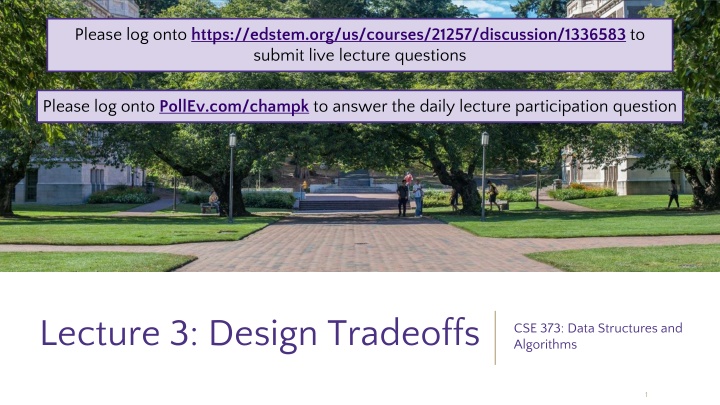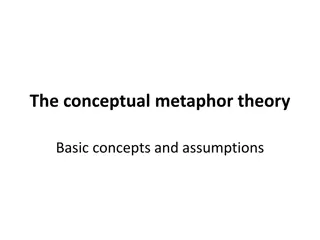Conceptual Data Modeling for Electronic Commerce Application
In this case study, explore the process of conceptual data modeling for an Electronic Commerce Application focusing on Pine Valley Furniture WebStore. Follow the steps taken by senior systems analyst Jim Woo to identify information categories, examine data flows, and construct an Entity-Relationship (E-R) diagram for the WebStore.
Download Presentation

Please find below an Image/Link to download the presentation.
The content on the website is provided AS IS for your information and personal use only. It may not be sold, licensed, or shared on other websites without obtaining consent from the author.If you encounter any issues during the download, it is possible that the publisher has removed the file from their server.
You are allowed to download the files provided on this website for personal or commercial use, subject to the condition that they are used lawfully. All files are the property of their respective owners.
The content on the website is provided AS IS for your information and personal use only. It may not be sold, licensed, or shared on other websites without obtaining consent from the author.
E N D
Presentation Transcript
Please log onto https://edstem.org/us/courses/21257/discussion/1336583 to submit live lecture questions Please log onto PollEv.com/champk to answer the daily lecture participation question Lecture 3: Design Tradeoffs CSE 373: Data Structures and Algorithms 1
Warm Up Please fill out the Poll at- pollev.com/champk Q: Would you use a LinkedList or ArrayList implementation for each of these scenarios? ArrayList uses an Array as underlying storage LinkedList uses nodes as underlying storage Situation #1: Choose a data structure that implements the List ADT that will be used to store a list of songs in a playlist. ArrayList LinkedList state data[] size state Node front size behavior Situation #2: Choose a data structure that implements the List ADT that will be used to store the history of a bank customer s transactions. behavior get return data[index] set data[index] = value add data[size] = value, if out of space grow data insert shift values to make hole at index, data[index] = value, if out of space grow data delete shift following values forward size return size get loop until index, return node s value set loop until index, update node s value add create new node, update next of last node insert create new node, loop until index, update next fields delete loop until index, skip node size return size List ADT state Situation #3: Choose a data structure that implements the List ADT that will be used to store the order of students waiting to speak to a TA at a tutoring center Set of ordered items Count of items behavior get(index) return item at index set(item, index) replace item at index append(item) add item to end of list insert(item, index) add item at index delete(index) delete item at index size() count of items 0 1 2 3 4 88.6 26.1 94.4 0 0 94.4 88.6 26.1 free space list CSE 373 22 SP CHAMPION 2
Announcements Course website live with slides HW 0 143 Review Project -Live on website -Due Wednesday CSE 373 22 SP CHAMPION 3
Design Decisions For every ADT there are lots of different ways to implement them Based on your situation you should consider: -Memory vs Speed -Generic/Reusability vs Specific/Specialized -One Function vs Another -Robustness vs Performance This class is all about implementing ADTs based on making the right design tradeoffs! > A common topic in interview questions CSE 373 19 WI - KASEY CHAMPION 4
Note: You dont have to understand all of this right now we ll dive into it soon. Review: Complexity Class complexity class: A category of algorithm efficiency based on the algorithm's relationship to the input size N. Big-O Example Algorithm Complexity Class constant Runtime if you double N unchanged O(1) Accessing an index of an array Binary search logarithmic O(log2N) increases slightly linear O(N) doubles Looping over an array log-linear O(N log2N) Merge sort algorithm slightly more than doubles quadratic O(N2) quadruples Nested loops! ... ... ... ... exponential O(2N) multiplies drastically Fibonacci with recursion CSE 373 19 WI - KASEY CHAMPION 5
List ADT Design Tradeoffs Recall these basic Big-O ideas from 14X: Suppose our list has N elements -If a method takes a constant number of steps (like 23 or 5) its running time is O(1) -If a method takes a linear number of steps (like 4N+3) its running time is O(N) For ArrayLists and LinkedLists, what is the O() for each of these operations? -Time needed to access N^th element: -Time needed to insert at end (the array is full!) What are the memory tradeoffs for our two implementations? -Amount of space used overall -Amount of space used per element Time needed to access N^th element: -ArrayList: O(1) constant time -LinkedList: O(N) linear time Time needed to insert at N^th element (the array is full!) -ArrayList: O(N) linear time -LinkedList: O(N) linear time Amount of space used overall -ArrayList: sometimes wasted space -LinkedList: compact Amount of space used per element -ArrayList: minimal -LinkedList: tiny extra CSE 373 22 SP CHAMPION 6
Real-World Scenarios - Lists LinkedList Image viewer - Previous and next images are linked, hence can be accessed by next and previous button - Dynamic memory allocation - We use linked list of free blocks - Implementations of other ADTs such as Stacks, Queues, Graphs, etc. - ArrayList Maintaining Database Records - List of records you want to add / delete from and maintain your order after - Music Player Songs in music player are linked to previous and next song. you can play songs either from starting or ending of the list - CSE 373 19 WI - KASEY CHAMPION 7
Design Decisions Situation #1: Write a data structure that implements the List ADT that will be used to store a list of songs in a playlist. ArrayList optimize for the ability to shuffle play on the playlist LinkedList - optimize for adding/removing/changing order of songs Situation #2: Write a data structure that implements the List ADT that will be used to store the history of a bank customer s transactions. ArrayList optimize for accessing of elements and adding to back LinkedList - if structured backwards, could optimize for addition to front Situation #3: Write a data structure that implements the List ADT that will be used to store the order of students waiting to speak to a TA at a tutoring center LinkedList - optimize for removal from front ArrayList optimize for addition to back CSE 373 22 SP CHAMPION
Questions? CSE 373 SP 18 - KASEY CHAMPION 9
Two more ADTs: Stacks and Queues CSE 373 19 SU - ROBBIE WEBER
Review: What is a Stack? stack: A collection based on the principle of adding elements and retrieving them in the opposite order. -Last-In, First-Out ("LIFO") -Elements are stored in order of insertion. - We do not think of them as having indexes. -Client can only add/remove/examine the last element added (the "top"). push pop, peek top 3 2 1 Stack ADT supported operations: -push(item): Add an element to the top of stack -pop(): Remove the top element and returns it -peek(): Examine the top element without removing it -size(): how many items are in the stack? -isEmpty(): true if there are 1 or more items in stack, false otherwise bottom state Set of ordered items Number of items behavior push(item) add item to top pop() return and remove item at top peek() look at item at top size() count of items isEmpty() count of items is 0? CSE 143 SP 17 ZORA FUNG 11
Implementing a Stack with an Array Stack ADT ArrayStack<E> Big O Analysis state Set of ordered items Number of items O(1) Constant state data[] size pop() O(1) Constant peek() behavior behavior push data[size] = value, if out of room grow data pop return data[size - 1], size-1 peek return data[size - 1] size return size isEmpty return size == 0 size() O(1) Constant push(item) add item to top pop() return and remove item at top peek() look at item at top size() count of items isEmpty() count of items is 0? isEmpty() O(1) Constant O(N) linear if you have to resize O(1) otherwise push() 0 1 2 3 push(3) push(4) pop() push(5) Take 1 min to respond to activity 3 4 5 www.pollev.com/cse373activity What do you think the worst possible runtime of the push() operation will be? numberOfItems = 0 1 2 CSE 373 19 WI - KASEY CHAMPION 12
Implementing a Stack with Nodes Stack ADT LinkedStack<E> Big O Analysis state Set of ordered items Number of items O(1) Constant state Node top size pop() O(1) Constant peek() behavior behavior push add new node at top pop return and remove node at top peek return node at top size return size isEmpty return size == 0 size() O(1) Constant push(item) add item to top pop() return and remove item at top peek() look at item at top size() count of items isEmpty() count of items is 0? isEmpty() O(1) Constant O(1) Constant push() 4 Take 1 min to respond to activity push(3) push(4) pop() front 3 www.pollev.com/cse373activity What do you think the worst possible runtime of the push() operation will be? numberOfItems = 0 1 2 CSE 373 19 WI - KASEY CHAMPION 13
Real-World Scenarios - Stacks - Undo/Redo Feature in editing software - DNA Parsing Implementation - https://www.nature.com/articles/s41467-021-25023-6 - stack is able to record combinations of two different DNA signals, release the signals into solution in reverse order, and then re-record - social implications + ethical concerns? - accuracy limits - performance of stack dependent on efficiency of washing steps between stack operations - what if certain DNA needs more stack operations to parse than other? what kind of inequalities can this create between more common and more rare DNA? what are some social consequences of using a stack for DNA sequencing? CSE 373 19 WI - KASEY CHAMPION 14
Review: What is a Queue? queue: Retrieves elements in the order they were added. -First-In, First-Out ("FIFO") -Elements are stored in order of insertion but don't have indexes. -Client can only add to the end of the queue, and can only examine/remove the front of the queue. front back Queue ADT remove, peek add 1 2 3 state Set of ordered items Number of items supported operations: -add(item): aka enqueue add an element to the back. -remove(): aka dequeue Remove the front element and return. -peek(): Examine the front element without removing it. -size(): how many items are stored in the queue? -isEmpty(): if 1 or more items in the queue returns true, false otherwise behavior add(item) add item to back remove() remove and return item at front peek() return item at front size() count of items isEmpty() count of items is 0? CSE 143 SP 17 ZORA FUNG 15
Implementing a Queue with an Array Queue ADT ArrayQueue<E> Big O Analysis O(1) Constant state Set of ordered items Number of items remove() state data[] Size front index back index O(1) Constant peek() behavior size() O(1) Constant add(item) add item to back remove() remove and return item at front peek() return item at front size() count of items isEmpty() count of items is 0? behavior add data[size] = value, if out of room grow data remove return data[size - 1], size-1 peek return data[size - 1] size return size isEmpty return size == 0 isEmpty() O(1) Constant O(N) linear if you have to resize O(1) otherwise add() 0 1 2 3 4 add(5) add(8) add(9) remove() 5 8 9 0 1 2 3 numberOfItems = front = 0 back = 0 1 2 1 CSE 373 19 WI - KASEY CHAMPION 16
Implementing a Queue with an Array > Wrapping Around front back add(7) add(4) add(1) 0 1 2 3 4 4 5 9 2 7 front 3 4 5 numberOfItems = back 0 1 2 3 4 5 6 7 8 9 1 5 9 2 7 4 CSE 373 SP 22 - CHAMPION 17
Implementing a Queue with Nodes Queue ADT LinkedQueue<E> Big O Analysis O(1) Constant state Set of ordered items Number of items remove() state Node front Node back size O(1) Constant peek() behavior size() O(1) Constant add(item) add item to back remove() remove and return item at front peek() return item at front size() count of items isEmpty() count of items is 0? behavior add add node to back remove return and remove node at front peek return node at front size return size isEmpty return size == 0 isEmpty() O(1) Constant add() O(1) Constant Take 1 min to respond to activity numberOfItems = 0 1 2 www.pollev.com/cse373activity What do you think the worst case runtime of the add() operation will be? add(5) add(8) remove() front 5 8 back CSE 373 19 WI - KASEY CHAMPION 18
Real-World Examples Serving requests on a single shared resource e.g. a printer, CPU task scheduling, etc. Call Center phone systems use Queues to hold people calling them in order, until a service representative is free. Handling of interrupts in real-time systems. The interrupts are handled in the same order as they arrive i.e First come first served. 19
Design Decisions Activity: Talk to those around you! Discuss with your neighbors: For the following scenario select the appropriate ADT and implementation and explain why they are optimal for this situation. Situation: You are writing a program to schedule jobs sent to a laser printer. The laser printer should process these jobs in the order in which the requests were received. There are busy and slow times for requests that can have large differences in the volume of jobs sent to the printer. Which ADT and what implementation would you use to store the jobs sent to the printer? Kasey s Answer ADT options: - List - Stack - Queue Implementation options: - array - linked nodes LinkedQueue This will maintain the original order of the print jobs, but allow you to easily cancel jobs stuck in the middle of the queue. This will also keep the space used by the queue at the minimum required levels despite the fact the queue will have very different lengths at different times. 20 CSE 373 22 SP - CHAMPION
Questions? CSE 373 SP 18 - KASEY CHAMPION 21
Dictionaries CSE 373 19 SU - ROBBIE WEBER
Dictionaries (aka Maps) Every Programmer s Best Friend You ll probably use one in almost every programming project. -Because it s hard to make a big project without needing one sooner or later. // two types of Map implementations supposedly covered in CSE 143 Map<String, Integer> map1 = new HashMap<>(); Map<String, String> map2 = new TreeMap<>(); CSE 373 19 SU - ROBBIE WEBER
Review: Maps key value at" 43 key value in" 37 key value you" 22 map: Holds a set of distinct keys and a collection of values, where each key is associated with one value. -a.k.a. "dictionary" key value the" 56 56 map.get("the") supported operations: -put(key, value): Adds a given item into collection with associated key, -if the map previously had a mapping for the given key, old value is replaced. -get(key): Retrieves the value mapped to the key -containsKey(key): returns true if key is already associated with value in map, false otherwise -remove(key): Removes the given key and its mapped value Dictionary ADT state Set of items & keys Count of items behavior put(key, item) add item to collection indexed with key get(key) return item associated with key containsKey(key) return if key already in use remove(key) remove item and associated key size() return count of items CSE 373 19 SU - ROBBIE WEBER
2 Minutes Implementing a Dictionary with an Array Big O Analysis (if key is the last one looked at / not in the dictionary) ArrayDictionary<K, V> Dictionary ADT put() O(N) linear state Pair<K, V>[] data state Set of items & keys Count of items get() O(N) linear behavior containsKey() behavior O(N) linear put find key, overwrite value if there. Otherwise create new pair, add to next available spot, grow array if necessary get scan all pairs looking for given key, return associated item if found containsKey scan all pairs, return if key is found remove scan all pairs, replace pair to be removed with last pair in collection size return count of items in dictionary put(key, item) add item to collection indexed with key get(key) return item associated with key containsKey(key) return if key already in use remove(key) remove item and associated key size() return count of items remove() O(N) linear O(1) constant size() Big O Analysis (if the key is the first one looked at) put() O(1) constant get() O(1) constant containsKey( c ) get( d ) put( b , 97) put( e , 20) containsKey() O(1) constant 0 1 2 3 4 remove() O(1) constant ( e , 20) ( a , 1) ( b , 2) ( c , 3) ( d , 4) 97) O(1) constant size() CSE 373 19 SU - ROBBIE WEBER
2 Minutes Implementing a Dictionary with Nodes Big O Analysis (if key is the last one looked at / not in the dictionary) Dictionary ADT LinkedDictionary<K, V> put() O(N) linear state Set of items & keys Count of items state front size get() O(N) linear behavior behavior containsKey() O(N) linear put if key is unused, create new with pair, add to front of list, else replace with new value get scan all pairs looking for given key, return associated item if found containsKey scan all pairs, return if key is found remove scan all pairs, skip pair to be removed size return count of items in dictionary put(key, item) add item to collection indexed with key get(key) return item associated with key containsKey(key) return if key already in use remove(key) remove item and associated key size() return count of items remove() O(N) linear O(1) constant size() Big O Analysis (if the key is the first one looked at) O(1) constant put() O(1) constant containsKey( c ) get( d ) put( b , 20) get() front O(1) constant containsKey() O(1) constant remove() O(1) constant 7 20 b c 9 d 4 a 1 size() CSE 373 19 SU - ROBBIE WEBER
Real-World Examples Used for fast data lookups & hashing Symbol table for compilers Database indexing Data stored in databases is generally of the key-value format which is done through hash tables. Caches Unique data representation Every time we type something to be searched in google chrome or other browsers, it generates the desired output based on the principle of hashing Message Digest a function of cryptography also uses hashing for creating output in such a manner that reaching to the original input from that generated output is almost next to impossible Computer File Managing each file has two very crucial information that is, filename and file path, in order to make a connection between the filename to its corresponding file path hash tables are used 27
Questions? CSE 373 SP 18 - KASEY CHAMPION 28























